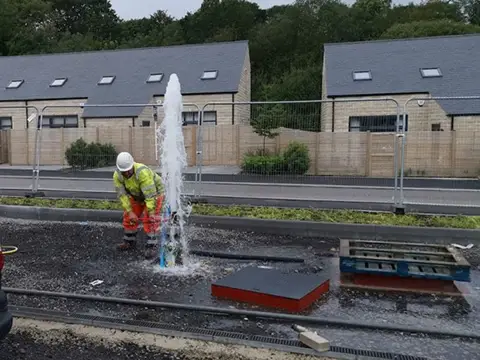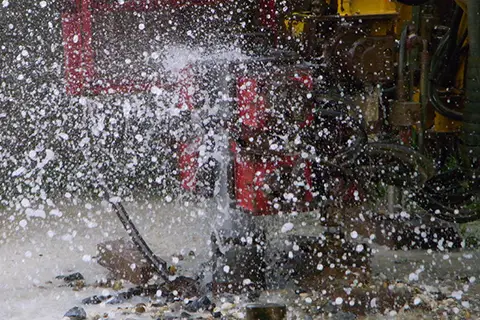Private Water Supply
Discover why high-water users and developers should consider private water supply. Igne designs and drills sustainable boreholes for resilience and control.
In recent weeks, the challenges facing the UK’s water network have dominated headlines. Contamination events, drought risk, and aging infrastructure have all highlighted a simple truth: our national water system is under pressure.
For many, this is an inconvenience. For others, particularly those with high or critical water demand, it’s a wake-up call.
At Igne, where we design and drill boreholes that tap directly into the natural aquifers beneath our feet, we believe it’s time for higher water users and new property developments to start thinking seriously about private water supply, either as a main source or as a strategic backup.
Rethinking Resilience
Water security has become an operational issue, not just an environmental one.
Large industrial facilities, food and drink manufacturers, data centres, leisure complexes, and agricultural sites depend on consistent supply. When that supply falters, whether due to contamination, drought restrictions or burst mains, the costs of downtime can be eye-watering.
A private water supply provides independence, continuity, and control. A correctly designed borehole system gives businesses direct access to groundwater that has often been naturally filtered over decades. Combined with modern treatment and monitoring systems, it can deliver high-quality, reliable water.
The Case for New Developments
For developers, this moment represents an opportunity.
As planning policy evolves and sustainability expectations rise, resilience is fast becoming a differentiator. Designing in a private water supply from the outset, rather than retrofitting one later, allows developers to future-proof against shortages, add sustainability credentials, and even unlock cost savings over the lifecycle of a project.
At Igne, we’re increasingly working with design teams, environmental consultants and utilities coordinators to evaluate groundwater resource potential at the feasibility stage of a project. With the right data, abstraction testing and hydrogeological assessment, we can advise whether a private borehole could sustainably supply all or part of a site’s water needs.
For large housing, mixed-use or industrial developments, that foresight can be transformative, both financially and environmentally.
The Economics: Capital Cost vs Control
It’s true that establishing a private supply requires upfront investment: ground investigation, drilling, installation, treatment, and monitoring.
But when amortised over years of use, the cost per cubic metre of self-supplied water can be competitive. More importantly, it offers stability: independence from fluctuating utility prices, and protection from supply interruptions.
In a world of increasing operational risk, control has value. And with modern telemetry, remote monitoring, and automated treatment, managing a private system is simpler than ever.
Regulation and Responsibility
Private supply does come with some obligations – e.g., abstraction licensing, water quality monitoring, and sustainable yield management.
At Igne, our approach starts with responsible resource assessment. We design systems that protect the aquifer, meet regulatory requirements, and ensure long-term viability. Our teams carry out hydrogeological studies, pumping tests, water chemistry analysis, and treatment design, all tailored to the intended use, whether process, potable, or irrigation.
We also install full digital monitoring systems, complete with notifications and regular automated reporting to ensure performance, compliance, and peace of mind. And we support clients in ongoing compliance, working with the Environment Agency, Natural Resources Wales, and local authorities to ensure continued adherence to regulations.
Sustainability in Action
Private water supply isn’t just about security, it’s about sustainability.
When designed well, it can complement rainwater harvesting, greywater recycling, and demand-reduction measures to create a truly circular on-site water system. By abstracting responsibly and integrating treatment and reuse, businesses can reduce strain on regional networks and demonstrate tangible progress toward net-zero water and PAS 2080 carbon management goals.
This approach aligns perfectly with the One Igne ethos: combining environmental responsibility with engineering precision to make progress possible, sustainably.
A Practical Path Forward
If you’re a high-water user or planning a new development, here’s where to start:
- Assess feasibility early: commission a hydrogeological desk study to understand local aquifers and abstraction potential.
- Engage regulators proactively: early dialogue with environmental authorities smooths the licensing process.
- Design for redundancy: combine private and public supply to build resilience into your system.
- Think long term: consider lifecycle cost, operational risk, and sustainability benefits, not just capital outlay.
- Choose the right partner: work with a specialist that understands drilling, geology, regulation, and infrastructure integration.
Why Igne
Igne’s Specialist Drilling division brings together decades of expertise in groundwater abstraction, hydrogeology, and borehole construction. From initial feasibility through to design, drilling, installation, testing, treatment and maintenance, we deliver complete water supply systems for some of the UK’s largest industrial users.
Our experience spans sectors from manufacturing and agriculture to data infrastructure and energy, wherever water underpins progress.
If recent events have reminded us of anything, it’s that reliance on a single supply point is no longer enough. The organisations that thrive will be those that build resilience from the ground up, literally.
Interested in exploring private water supply options?
Talk to Igne’s Specialist Drilling team today, or discover your site’s subsurface potential.
Other articles of interest

Water abstraction licence
Since April 2005, abstractions of less than 20m3/day do not require licensing by the Environment Agency. If the abstraction is greater than 20m3/day a water abstraction licence will be required, and this is something we can manage for you as it can be a protracted affair to apply, and its complexity is often daunting.

Why we use biodegradable hydraulic oil
Why do we use biodegradable hydraulic oil when drilling water boreholes? Because it’s green, clean, non-carcinogenic and better for the planet.


